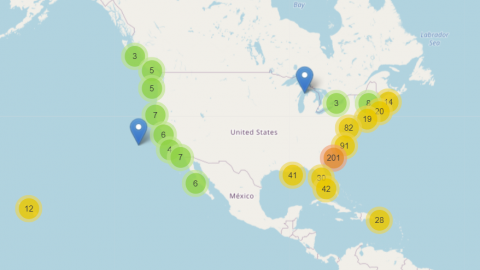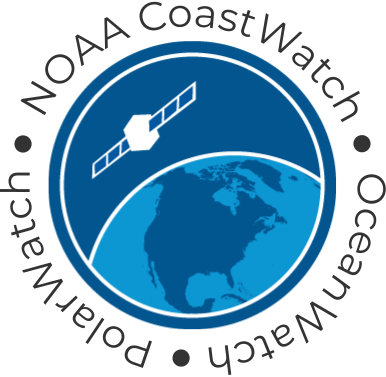Introduction
The NOAA CoastWatch/OceanWatch program has developed a NOAA focused In Situ Ocean Color Optics (ISOCO) Database to improve access, usability, and discovery of Ocean Color Calibration/Validation and Legacy Oceanographic Cruise data supported by NOAA. In conjunction with ongoing efforts to collect in situ optical and ancillary data for validation of JPSS VIIRS satellite ocean color radiometry and derived products, in situ data are aggregated and integrated into a user database for analysis with ongoing quality control to support the validation mission. Currently, the primary focus is on more recent and current cruise data from VIIRS calibration cruises, NOAA cruises of opportunity, and other collaborative cruises involving NOAA participation. The NOAA in situ database supports and enhances the larger integrated STAR Satellite and In Situ Quality Monitoring system under development at NOAA Satellite Oceanography and Climatology Division used for science quality data analysis and research in collaboration with the CoastWatch/OceanWatch group at STAR. This environmental oceanographic database will aid in improving our understanding of global ocean optical, biological, and biogeochemical parameterizations for societal benefit. Your contributions, in addition to being a NOAA requirement for data collected within NOAA programs, are greatly valued and will be fully referenced to help increase recognition of your dataset.
Data Sharing Policy (as of 1 October 2018)
The data shared in this NOAA in situ Ocean Color Optics Database are made freely available to the public and the scientific community with the intent that the wide dissemination of data lead to greater understanding, new insights and applications, and improved outcomes from decision-making and also in accordance with the NOAA Data and Publication Sharing Directive for NOAA Grants, Cooperative Agreements, and Contracts, V.3 (2016). The investigators sharing their data through this database rely on the ethics and integrity of the user to ensure that the institutions and investigators involved in producing these data receive fair credit for their work.
Users of data from this database are strongly urged to inform and discuss with the investigators listed in file metadata at the outset or early stages of use in potential publications or presentations so that the investigators can ensure that the quality and limitations of the data are accurately understood and represented. Co-authorship may be appropriate, especially if data are used for publication within 3 years of their collection date.
In all cases, users are strongly urged to acknowledge this database and cite any digital object identifiers (DOIs) associated with it or with individual data. Suggested text for database acknowledgement follows: [Some of the] Data used in this [study] were obtained from the NOAA in situ Ocean Color Optics Database distributed through NOAA CoastWatch/OceanWatch. A DOI is forthcoming.
Data Submissions
Please email Merrie Beth Neely (Merrie.Neely@noaa.gov) with cc to Veronica Lance (Veronica.Lance@noaa.gov) with “ISOCO Database File” in the subject line indicating your intent to submit data. Files are due within 180 days (6 months) from the last cruise day.
- Small data files (~< 10 MB or other according to your email limitation) can be submitted via attachment to the same email.
- Submission methods for larger files or large datasets composed of many files will be arranged on a case by case basis at this time.
File format. For your convenience, the NOAA database accepts the ascii/txt (i.e., similar to SeaBASS) format. Ultimately, the desired data format is netCDF, which will facilitate data discovery throughout NOAA systems (i.e., CoastWatch tools, NCEI archives, data.gov searches, etc.). As such, there may be some changes to the metadata fields in the future to accommodate conversion to netCDF.
Header metadata for data file. The following metadata are part of your data submission requirement for the NOAA ISOCO Database and can be used to generate a short Data Management Statement for cruise data submitted to the ISOCO Database, if one is not provided. For NOAA-funded or NOAA related projects, please submit your data with header information within six months after each cruise. These parameters build on the existing NASA/SeaBASS format for ease of data submission. The metadata parameters and data formats are described below.
Summary of ISOCO Database additional Parameters
- data_POC. Point of contact for the submitted data who can be contacted at the current and any future time. This may or may not be the Principle Investigator (PI).
- POC_Affiliations: Institutional affiliation for the data point of contact.
- POC_Econtact: Email address for the data point of contact.
- Instrument. Instrument and Model number used to collect the data, e.g., HyperPRO II profiler, Turner Designs 10AU Fluorometer.
- Ship_Name: Complete Vessel name, following any standardized format, e.g. NOAA Nancy Foster
- Data_Citation. Include any citation to the data which users can refer to, e.g., DOI, cruise report, ship report, funding agency number/citation, publication number/citation. If not available at the time of submission, enter ‘NAN’ and provide it to us as soon as possible for a database reference to your dataset.
- NOAA_Document: NOAA-required data description file should include protocol, instrument, brief description of methods, data uncertainty as appropriate for data submitted. Include a section called ‘Cruise/Experiment Description’. This should be two to three descriptive sentences about the cruise/experiment. Include full group name spelled out with acronym(s) in parentheses, physical location of cruise (region covered), start and end period, and ship name. One sentence about the purpose of the cruise if not included in the first sentence.
- Documents: Other supporting documents for this data which are not NOAA-required.
- Calibration_Files: Data file(s) documenting the calibration information for the instrument(s) used to collect the reported data, and at a minimum must include: the last instrument calibration date, names of personnel who performed the calibration, all reference standard(s) used in the calibration procedure, and a full citation – or copy - of the calibration protocols followed.
Note: Latitude/Longitude updated final data file. These values should be reviewed and confirmed before submitting your data, since multiple team members may have different values for their data collected at the same location. Please consult with your team members as needed on joint cruises.
See the SeaBASS link https://seabass.gsfc.nasa.gov/wiki/metadataheaders for further information about general header metadata parameters.
Metadata Element Details
Sample entries are provided following the “=” after each element name. Required NOAA fields that may differ from prior submissions are highlighted in blue.
====================================
/begin_header
/investigators= Micheal_Ondrusek
/affiliations=NOAA_STAR
/contact=Michael.Ondrusek@noaa.gov
/experiment=NOAA_VIIRS_OC
/cruise=EX-18-04
/data_ POC=Merrie_Beth_Neely
/POC_affiliations=Global_Science_and_Technology
/POC_econtact=Merrie.Neely@noaa.gov
/instrument=Turner_Designs_10AU
/station=17
/data_file_name=filename.dat
/original_file_name=filename.xls
/ship_name=NOAA_Okeanos_Explorer
/data_citation=NAN
/NOAA_documents=NOAAChlaSOPreadme.txt
/documents=filename_readme.txt
/calibration_files=filename_cals.txt
/data_type=pigment
/data_status=final
/start_date=20180508 [YYYYMMDD]
/end_date=20180518 [YYYYMMDD]
/start_time=13:00:00[GMT]
/end_time=15:00:35[GMT]
/north_latitude=42.135[DEC.DEG]
/south_latitude=42.055[DEG]
/east_longitude=-72.375[DEG]
/west_longitude=-72.420[DEG]
/water_depth=250 [m]
/measurement_depth=2.0 [m]
/secchi_depth=4.5 [m]
/cloud_percent=50 [m]
/wind_speed=5.0 [m]
/wave_height=1.0 [m]
!
! COMMENTS
!
! Slightly overcast, with large cumulous on horizon. Wind from NE.
!
! Turner fluorometer last calibrated: 12 December 2000
!
! lower limit of detection = 0.001 mg/m^3
!
/missing digital value=-9999
/missing_text_value= NAN
/below_detection_limit=-8888
/above_detection_limit=-7777
/delimiter=tab
/fields=time,depth,CHL,PHAEO,Tpg
/units=hh:mm:ss, m, mg/m^3,mg/m^3,mg/m^3
/end_header
====================================
Data Fields
See SeaBASS link https://seabass.gsfc.nasa.gov/wiki/stdfields#Table%20of%20Field%20Names%20and%20Units .
Additional NOAA Data Fields
| Data Field | Units | Description |
Rrs | 1/sr | Remote sensing reflectance (Lw / Ed) |
Rrs_sfc | 1/sr | Remote sensing reflectance (Lw / Ed) no NIR reflectance correction |
Rrs_fresnel | 1/sr | Remote sensing reflectance (Lw / Ed) Fresnel correction OMITTED |
Rrs_white | 1/sr | Remote sensing reflectance (Lw / Ed) White |
Rrs_lee | 1/sr | Remote sensing reflectance (Lw / Ed) Lee et al., 1997 method |
Rrs_gould1 | 1/sr | Remote sensing reflectance (Lw / Ed) Gould et al., 2001 method |

